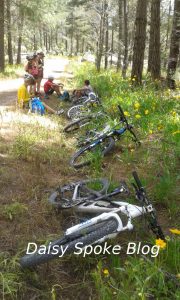Juggling the many roles and responsibilities we have can be a constant source of both satisfaction and despair. I talk to women every week about challenges like time management, and wanted to share some of the ideas that I’ve collected on how to stay sane when time seems to be your enemy.

TIME! We never seem to have enough of it, we’re always fighting it, and it’s invisible! It seems to slip through our fingers without care. It’s like an elusive double agent, tempting us with tantalising pleasures, and then it’s gone, leaving us with nothing but a pile of to-do’s and deadlines in its wake. And if we’re honest with ourselves, we’ll always find something to fill in a space that’s left when we are more efficient with our time – there’ll never be enough of it!
Time Management is a real thing!
Managing the time we have available to us is a learned skill and one that we can continually refine as our needs, activities and priorities change. There are a lot of self-help books on this topic, but honestly, who has the time to read them! Assuming you’re in the same boat as me, I’ve short-listed some key time management strategies and helpful mindsets that I’ve collected over the years.
Time management strategies to stay sane when it feels like time is your enemy
1. Time is a commodity we exchange for something else
Time is a precious commodity that I give in exchange for something else. It’s a transaction; a business deal between myself and the universe. If I spend lots of money on luxury items, eating out, holidays and new clothes, I may not (ummm ….. actually I won’t) have enough left over for the basic household bills like groceries, fuel for the car, and electricity. Time is like money – think about how you can spend it wisely!
2. We have a choice
We have choices about how we spend our time, in the same way that we have choices about spending our money. What choices are you making?
3. Get your priorities straight
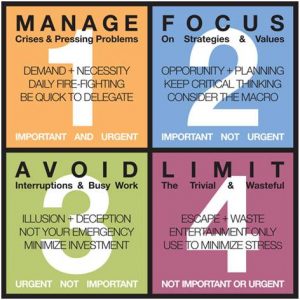
With so many different things competing for our time and energy, we are constantly needing to prioritise. And I mean constantly! It’s an ongoing process. Everyday – prioritise. Every hour – prioritise. Every minute – prioritise. Every moment – prioritise. It’s a valuable skill – the more practise you get, the better you’ll become at getting your priorities straight.
If you have trouble identifying what’s most important and what’s most urgent, invest just a few minutes of your time reading about Stephen Covey’s Time Management Matrix here
4. Time is precious
Time can never be refunded once it’s spent. Thinking of time as precious gift to be treasured and used wisely can help us to make carefully considered choices about how we are using it.
5. What are your time vampires?
What is it that sucks the time out of your day? Where does your time go? Are you okay about this?
6. Record your actions for a day, or longer!
I’ve found this really helpful at times. You can make a note in your diary or notepad of how you are spending your day. Note down the time and what task or activity you are working on, and what time you finished. Or you could break your diary into 10 or 15 minute time blocks and make a note of what you are doing at every time interval. It only takes a teeny bit of time to do this, but the investment is well worthwhile! These actions can highlight where our time goes, and keeps us more accountable to our goals.
7. Ask yourself “What am I doing now?”
This precious moment is all we have. How are you spending your energy and time right now, in this precious moment?
8. Don’t make excuses
It’s easy to blame other people and situations for our poverty of time. Do a thorough audit and be honest with yourself. What can you take responsibility for? What change can you make?
9. Avoid distractions
Is distraction an issue for you?
- Set a timer to go off at regular intervals to remind you to refocus your attention
- Switch off your wi-fi
- Close your door
- Turn off your phone
- Put a “Do Not Disturb” sign on your office
- Reward yourself when you’ve completed tasks
…. whatever you need, just do it. Make it as easy as possible to keep your attention laser-focused.

Make friends with the time you have!
- Time is a commodity – spend it wisely!
- You choose moment to moment how you spend you time
- Get your priorities straight – is it important / urgent?
- Time is precious
- What are your time vampires?
- Record how you spend your time
- Ask yourself “What am I doing now?”
- Don’t make excuses
- Avoid distractions
I’d love to hear any other time management strategies you use to stay sane when it feels like time is your enemy. Leave your comment below, send me a message, or head on over to my Facebook!
Discovering mountain biking as life’s ultimate parallel universe in her middle age,  Kathryn Walton shares information and reflections in Daisy Spoke that connect, inspire and self-empower women to make healthy choices for themselves. She integrates her love of physical exercise, family, nature, gardening and creative arts with her professional background in mental health social work to facilitate change with individuals, groups and communities of women who are committed to living life to the full.
Kathryn Walton shares information and reflections in Daisy Spoke that connect, inspire and self-empower women to make healthy choices for themselves. She integrates her love of physical exercise, family, nature, gardening and creative arts with her professional background in mental health social work to facilitate change with individuals, groups and communities of women who are committed to living life to the full.

 was missing it.
was missing it.  I’ve been practising and teaching this technique for a lot of years, and yet still I sometimes forget to do it when the moment arises. The thing is that on Sunday morning I DID NOTICE those fearful thoughts bouncing round my head. And guess what?
I’ve been practising and teaching this technique for a lot of years, and yet still I sometimes forget to do it when the moment arises. The thing is that on Sunday morning I DID NOTICE those fearful thoughts bouncing round my head. And guess what? 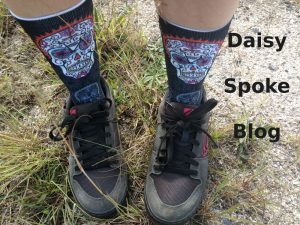 of short hills engaging my quads in an exertion that a couple of years ago would have been painful (if not impossible)! I pedalled in a higher gear than normal and found it easier than expected.
of short hills engaging my quads in an exertion that a couple of years ago would have been painful (if not impossible)! I pedalled in a higher gear than normal and found it easier than expected.  The key to managing this is to NOTICE that it’s happening. If you are are not aware of your inner chatter, you will unconsciously believe it and go along with it instead of challenging it.
The key to managing this is to NOTICE that it’s happening. If you are are not aware of your inner chatter, you will unconsciously believe it and go along with it instead of challenging it.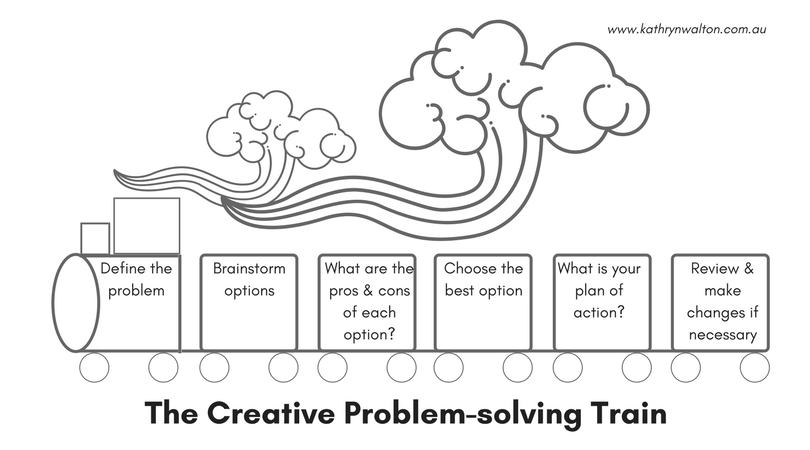
 The Carriages (or steps, if you prefer!)
The Carriages (or steps, if you prefer!) analysing
analysing  5. Write down your Plan of Action so that you have a clear and concise guide to implementing your selected option.
5. Write down your Plan of Action so that you have a clear and concise guide to implementing your selected option. more time? More resources?
more time? More resources? 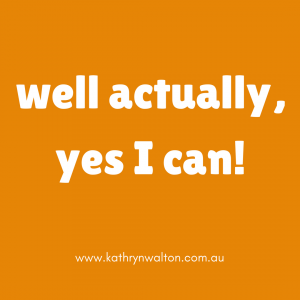 Blending creativity and logic is a powerful way to achieve success. Don’t allow your inner chatter stop you from getting started with your goals. And don’t let the obstacles limit you or your achievements. Follow the Creative Problem-solving Train to develop persistence and propel you forwards. Your mental health will thank you with improved self-confidence, resilience and unstoppability.
Blending creativity and logic is a powerful way to achieve success. Don’t allow your inner chatter stop you from getting started with your goals. And don’t let the obstacles limit you or your achievements. Follow the Creative Problem-solving Train to develop persistence and propel you forwards. Your mental health will thank you with improved self-confidence, resilience and unstoppability. Click here to read my last blog post
Click here to read my last blog post 
 example of mine was
example of mine was 
 You can collect them from songs, poems, books and social media in addition to listening to your own inner wisdom. Write them on sticky notes, in a journal or diary, print out visual reminders to stick around your home or workplace, or even use them as screen savers and wallpapers on your electronic devices. Some examples include “Just do it”, “One drop raises the ocean”, “Keep it simple”, “Just breathe”, “Stand tall”.
You can collect them from songs, poems, books and social media in addition to listening to your own inner wisdom. Write them on sticky notes, in a journal or diary, print out visual reminders to stick around your home or workplace, or even use them as screen savers and wallpapers on your electronic devices. Some examples include “Just do it”, “One drop raises the ocean”, “Keep it simple”, “Just breathe”, “Stand tall”.
 lying on the beach, your stresses trickling away into the sand beneath you) or to help you progress towards a goal (eg visualise yourself speaking in front of an audience, feeling confident, upright posture, smiling, relaxed). When I’m feeling nervous about riding my bike on a particular section of track, I stop for a few moments and picture myself riding it the way I want it to go, as if I’m watching a short video of myself successfully negotiating that section. It truly is a powerful mind-based strategy and one you can use in every area of your life.
lying on the beach, your stresses trickling away into the sand beneath you) or to help you progress towards a goal (eg visualise yourself speaking in front of an audience, feeling confident, upright posture, smiling, relaxed). When I’m feeling nervous about riding my bike on a particular section of track, I stop for a few moments and picture myself riding it the way I want it to go, as if I’m watching a short video of myself successfully negotiating that section. It truly is a powerful mind-based strategy and one you can use in every area of your life.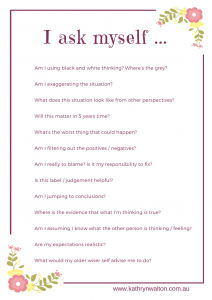 the mix. And to help you keep your strategies in play, I’ve created a free printable for you. “I ask myself …” is a beautiful keepsake of the helpful questions listed above. You can
the mix. And to help you keep your strategies in play, I’ve created a free printable for you. “I ask myself …” is a beautiful keepsake of the helpful questions listed above. You can 

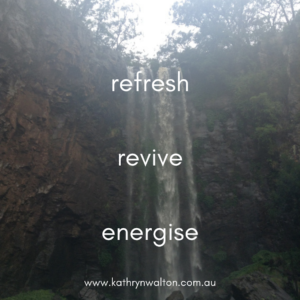
 Kathryn Walton shares information and reflections in Daisy Spoke that connect, inspire and self-empower women to make healthy choices for themselves.
Kathryn Walton shares information and reflections in Daisy Spoke that connect, inspire and self-empower women to make healthy choices for themselves.
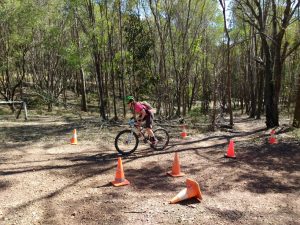 whole race. On the physical side there were the cramps and nausea right from the start, and mentally I was hypervigilant about the other riders around me and fearful that I’d mess up on the technical features. When I finished I only felt relief, and no great desire to repeat the experience. After some time to reflect I became determined not to give in, not to let this beat me, and I had a strong sense that I needed to go back to Chicks in the Sticks this year with a new goal of finding enjoyment in the process of racing.
whole race. On the physical side there were the cramps and nausea right from the start, and mentally I was hypervigilant about the other riders around me and fearful that I’d mess up on the technical features. When I finished I only felt relief, and no great desire to repeat the experience. After some time to reflect I became determined not to give in, not to let this beat me, and I had a strong sense that I needed to go back to Chicks in the Sticks this year with a new goal of finding enjoyment in the process of racing.


 On my second last lap I had a quick stop for more water and felt a bit disturbed when another rider had a nasty fall. It could have been me. It could have been any of us. I rode more mindfully after that, knowing that I was getting tired and this is when accidents are more likely to occur. On my last lap I wriggled my right toes which had been feeling numb through the race and then the cramp struck me! Repeatedly! But I kept going and was able to laugh it off without falling off! Hmmm…. I thought ….. maybe I didn’t get my nutrition and hydration quite right! But I didn’t care. I hadn’t felt nauseous at all so I knew I’d done better than last year!
On my second last lap I had a quick stop for more water and felt a bit disturbed when another rider had a nasty fall. It could have been me. It could have been any of us. I rode more mindfully after that, knowing that I was getting tired and this is when accidents are more likely to occur. On my last lap I wriggled my right toes which had been feeling numb through the race and then the cramp struck me! Repeatedly! But I kept going and was able to laugh it off without falling off! Hmmm…. I thought ….. maybe I didn’t get my nutrition and hydration quite right! But I didn’t care. I hadn’t felt nauseous at all so I knew I’d done better than last year! skill level which contributed to my confidence as well. And the fact that the element of FUN played a major role on the day says it all for me. If I can have fun at this thing called mountain biking, then I’m definitely dealing with those demons that hold me back in life. That’s what I call progress!
skill level which contributed to my confidence as well. And the fact that the element of FUN played a major role on the day says it all for me. If I can have fun at this thing called mountain biking, then I’m definitely dealing with those demons that hold me back in life. That’s what I call progress!

